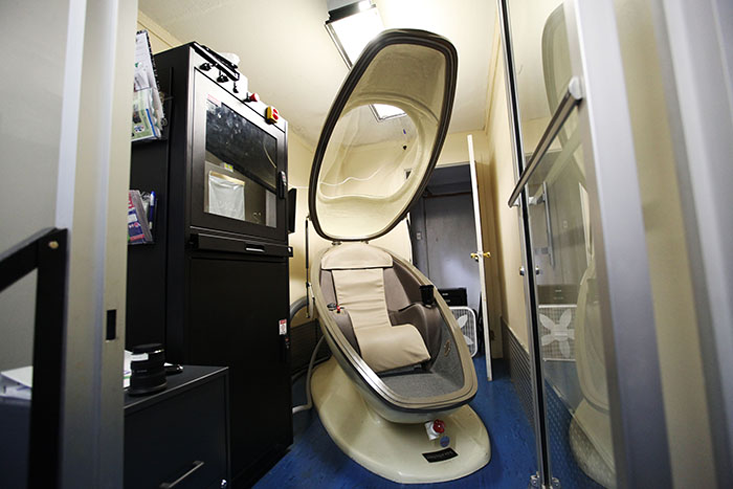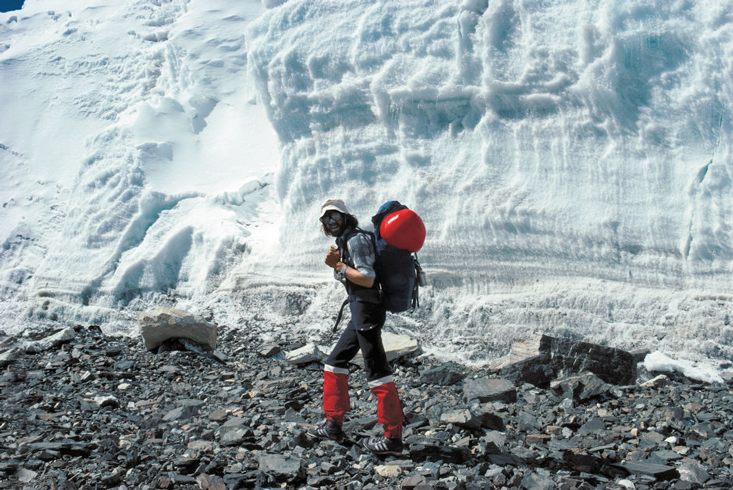We’re usually comfortable deciding whether or not an athlete is doping. Lance Armstrong was definitely doping by using erythropoietin. Tennis player Novak Djokovic, on the other hand, was definitely not doping when he slept in an egg-shaped barometric chamber.
We tell one from the other by a kind of cultural gestalt, sorting out those who dope and those who don’t. Then we take that one step farther and reason: Those who don’t, compete cleanly—those that do, cheat.
But what if a substance is both performance-enhancing and a benefit to an athlete’s health? What if that substance is oxygen?

The top of Everest is in what the Swiss alpinist Edouard Wyss-Dunant nicknamed the “death zone,” meaning altitudes exceeding 26,000 feet. One of 14 mountains on Earth that have summits this high, Everest wreaks havoc on the human body. Early symptoms of altitude’s effects include dizziness, sluggishness, nausea, and fainting. If symptoms are left untreated, they quickly cascade, with increasingly dire consequences to climbers as air is choked out of their bodies. Even below the death zone, altitude can have serious repercussions.
The best way to mitigate the risk of high altitude climbing is to increase the amount of oxygen in a climber’s blood. Climbers can do this in a number of ways. One is to spend extensive time acclimatizing to high elevation along their chosen route. They can also use drugs like acetazolamide or dexamethasone, which reduce a variety of altitudinal conditions.
Perhaps the most controversial course of action, though, is the decision to carry and use supplemental O2. Most climbers consider their supplemental oxygen as equipment—just as much a part of their experience as their Gore-Tex gear, and certainly as foundational as their extensive training.1
But using supplemental oxygen sounds vaguely like doping. In fact, prominent elements of alpine climbing culture see it as illegitimate. Famous professional climbers like Ed Viesturs, the only American to have climbed all 14 8,000-meter peaks,1 deride the use of supplemental oxygen and have for decades.2 Using it, they maintain, is indeed like doping—with all the associated stigma heaped on it. “It brings the mountain down to your level,” Veisturs writes. “I don’t want that. If I have to train harder or suffer more, then so be it.”3
Another elite alpinist, Cory Richards, said in an interview with National Geographic in April of this year that climbing without oxygen was a way of advancing the sport. “[It] is one of those things that amounts to adhering to our highest standard,” Richards reasoned when asked about his upcoming attempt at Everest sans O2. “Rather than just bringing people up to the curve, it’s about bringing the whole curve up. The more people who climb Everest without oxygen, the less oxygen we will see on this mountain.”3
All high altitude climbers are at risk of irreversible brain damage as a result of oxygen-starved environments.
By one reading of world anti-doping rules, they have a point. The World Anti-Doping Association (WADA) prohibits an athlete from using a substance that fulfills two of the following three criteria: 1) It is performance-enhancing; 2) It is harmful to health; 3) It runs counter to the spirit of the sport. If elite alpinists like Viesturs and Richards are successful in convincing the broader alpinism culture, then oxygen would satisfy two of these three criteria.
Similarly, the United States Anti-Doping Agency 2016 athlete guide specifically prohibits “enhancing the uptake, transport, or delivery of oxygen,” whether it is by blood doping, intravenous manipulation of the contents of blood, or other means. Substances that help the body process or transport oxygen, like erythropoietin, are likewise banned. By these rules, carrying an O2 tank with you on an ascent certainly raises questions.
The only problem is that, for most, climbing without supplemental O2 dramatically increases the risk of death.

On June 23, 1802, explorer Alexander von Humboldt began an ascent of Mount Chimborazo in Ecuador. Climbing with naturalist Aimé Bonpland and local Quito student Carlos Montufar, von Humboldt scaled to a 19th-century record altitude of 19,286 feet, and experienced what he described as nausea and stomach cramping.4 His team returned with bloodshot eyes, and bleeding gums and lips.
Von Humboldt’s account of his experience is one of the first systematic descriptions by a climber and naturalist of high altitude’s utterly debilitating effects on human physiology. It came after centuries of investigation by natural philosophers, from Aristotle to Robert Hooke to Paul Bert, into the effect of air on living organisms.5
Where von Humboldt’s team was perplexed by their symptoms, today, climbers are well-educated that these are early signs of what can lead to serious complications.4 Contemporary medical researchers call what the Humboldt team experienced acute mountain sickness (AMS). While its causes are not fully understood, cerebral swelling, vasodilation, and alteration of the blood-brain barrier may all be involved.6 Effects of AMS can be felt as low as 8,000 feet.
Untreated, the symptoms of AMS will progress, ultimately resulting in conditions like high altitude pulmonary edema, in which fluid accumulates in the lungs, or high altitude cerebral edema, in which the brain swells and pushes against the skull, causing a loss of coordination, coma, and eventually death. The progression of symptoms can be fast, sometimes within 48 hours. Those who suffer from high altitude cerebral edema can take weeks to recover, even if they receive treatment.
The really unforgivable offense in the alpine climbing community is to lie about the conditions of an ascent.
In an attempt to quantify the neurological effects of high-altitude climbing, doctors Nicolas Fayed, Pedro Modrego, and Humberto Morales compiled a series of brain scans of 35 alpinists before and after ascents of Everest (29,029 feet), Aconcagua (22,840 feet), Mont Blanc (15,776 feet), and Kilimanjaro (19,341 feet). The authors’ findings, published in 2006, were sobering.7
They concluded that all high altitude climbers are at risk of irreversible brain damage as a result of time spent in oxygen-starved environments. The simple act of climbing at elevations with reduced oxygen increased the risk of brain damage, even with time spent acclimatizing before ascent. Everyone from alpinists who classified themselves as amateurs and were climbing at the relatively “low elevations” of Mont Blanc to seasoned professionals on Everest showed the effects of climbing at extreme elevations, ranging from symptoms associated with high altitude sickness to subcortical irreversible lesions. Even climbers who show no symptoms have displayed neurophysiological changes. “Climbers are paying [for their routes],” science writer R. Douglas Fields summarized in 2008, “with brain tissue.”8
Oxygen is the fuel that powers our bodies—the more fuel, the better we perform. Not enough oxygen and the body shuts down. We’ve known the risks and tradeoffs of oxygen deprivation at least since Tenzing Norgay and Edmund Hillary’s first ascent of Everest in 1953—with supplemental oxygen. When alpinists Reinhold Messner and Peter Habeler climbed Everest without supplemental oxygen in May of 1978, they effectively raised the bar in the community of alpine climbing. Even though estimates put only about 200 of Everest’s 4,000 successful ascents as summits without oxygen, that high-water remark remains. Some, inspired by Messner and Habeler’s ascent, feel that climbing without O2 represents the best of their sporting ethos, even if—especially if—that means that those sporting standards are high, never mind the risk.
The discussion extends beyond oxygen. Climbers also rely on a variety of drugs to help speed acclimatization to assist with their ascent. Acetazolamide (also known as Diamox) and dexamethasone (dex) are common artificial acclimatizers that help accelerate adjustment to altitude. Diamox blocks carbonic anhydrase, the enzyme that regulates how the body converts CO2 to bicarbonate, and dex stops capillaries from leaking. Both can be life-saving, and are recommended as immediate treatment for high-altitude edemas.1
They are also prohibited in other, non-climbing sports. Acetazolamide, for example, is banned by the World Anti-Doping Agency. Diuretics, like acetazolamide, have been forbidden in competitive athletics since 1988, since they can easily remove fluid from the body, causing one to experience rapid weight loss—significant for sports where athletes complete in specific weight categories. They can also be used to mask the presence of other, banned doping agents by increasing urine volume.
The U.S. anti-doping agency, WADA, and the Olympic committee have all not weighed in on the question of doping in alpinism. That’s because, while various governing bodies monitor and police other sports, alpinism is primarily internally regulated. It does have the International Climbing and Mountaineering Federation, but this is a very loose governing body. Consequently, what is and is not doping in alpinism does not fall under global regulations. Instead, these questions are actively debated and reflected in the sport’s evolving ethics and practices.
As a result, the real ethical line in the alpine climbing community doesn’t hinge on the questions of “oxygen” or “not oxygen” or even “dex” or “not dex,” but in the narrative that a climber builds about her ascent. “The world of cutting edge alpinism is small. Reputation is everything,” climber Gregory Crouch, the author of Enduring Patagonia, explains. “Climbers pushing that edge are not going to be impressed with someone dawdling up Everest, sucking on an oxygen bottle. Climbing a route in that style is kinda beneath contempt. It’s not worth noticing. What really matters in the world of real climbers is what you climb and how you climb it.”
Sports ethicist Verner Møller explains that it wasn’t always this way. “In the early days of alpinism, whatever could take you to the top was acceptable, because it was such a massive, physical challenge to climb such high elevations,” he says. “What we see now, however, is people saying, ‘This is not the right way to get to the top—you should not be able to use supplemental oxygen or other medicines.’ That’s a very purist approach to the activity.” The narrative has changed.
On its most fundamental level the really unforgivable offense in the alpine climbing community is to lie about the conditions of an ascent. In other words, claiming an ascent without oxygen if, in fact, a climber used it; or alluding to a dex-free climb, if, in reality, the drug helped accelerate an acclimatization. Because alpine climbing is removed from the arena of global competition—there aren’t Olympic teams of alpine climbers—the community isn’t trying to create a “level playing field” the way that other sports engineer an equal environment for competition. Climbing’s self-regulation—whether through shaming or ego—moves the discussion from ethics to aesthetics.
We see other sports differently. There, doping crosses a bright line, and is seen as clearly immoral. But the example of alpinism pulls at this confident appraisal. It reminds us that, even in the case of Armstrong or A-Rod, we object to doping because it violates a narrative about the sport. In his book The Ethics of Doping and Anti-Doping, Møller argues that “the doping problem has been constructed as a form of narrative blurring fact and fiction.” In other words, it is hard to have a sophisticated discussion of doping, because so much of the debate hinges on the moral story about it that society builds. This, he writes, has been accompanied by a uniform response to the issue, usually on the anti-doping side. “Only in very rare cases have athletes questioned the wisdom inherent in the actual anti-doping policy, and when it has happened they have been strongly opposed by sports’ leaders and fellow athletes.”9
Djokovic’s hyperbaric chamber is legit, but many players can’t possibly get access to one. Is that cheating? Conversely, treating supplemental oxygen as a performance-enhancing drug rather than a tool seems to be on par with asking Tour-de-France riders or NFL players to compete without their helmets. “If purists are to be consistent in their argument,” says Moller, “they should argue that one should not be allowed to go to the top of the mountain with one’s clothes on—alpinists’ clothes are incredible technologies in and of themselves—or have any kind of gear. That would be a truly pure ascent.”
As the oxygen debate in elite alpinism continues—and if history tells us anything, it’s that it will—alpinists will continue to consider and reconsider just how much of their physical selves they’re willing sacrifice in the name of their sporting ethos and climbing aesthetics. These types of conversations happen far less often in other sports. Maybe that should change. Alpinism’s approach to oxygen—as contentious and complicated as it is—gives us a model for an ethics that is flexible and evolutionary.
Lydia Pyne is a writer and historian of science, specializing in archaeology and paleoanthropology.
Lead Image from Buena Vista Images / Getty Images
References
1. Bezruchka, S. Altitude Illness: Prevention & Treatment The Mountaineers Books, Seattle, WA (2012).
2. Hoyt, A. How Mountaineer Ed Viesturs First Summited Everest Without Oxygen The Atlantic (2012).
3. Bisharat, A. What’s the Big Deal About Climbing Everest Without Oxygen? Beyond the Edge (2016).
4. Kutzinski, V.M. Alexander Von Humboldt’s Translantic Personae Routledge, London, U.K. (2014).
5. Heggie, V. Experimental physiology, Everest and oxygen: from the ghastly kitchens to the gasping lung. The British Journal for the History of Science 46, 123–147, (2013).
6. Kapoor, R., Narula, A.S., & Anand, A.C. Treatment of acute mountain sickness and high altitude pulmonary oedema. Medical Journal Armed Forces India 60, 384-387 (2004).
7. Fayed, N., Modrego, P.J., & Morales, H. Evidence of brain damage after high-altitude climbing by means of magnetic resonance imaging. The American Journal of Medicine 119, 168.e1-6 (2006).
8. Fields, R.D. Into Thin Air: Mountain Climbing Kills Brain Cells Scientific American (2008).
9. Møller, V. The Ethics of Doping and Anti-Doping: Redeeming the Soul of Sport? Routledge, London, U.K. (2009).




























